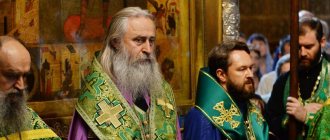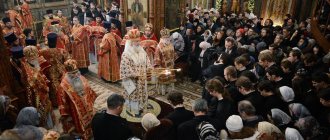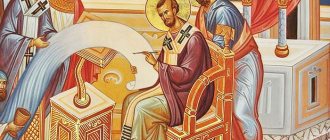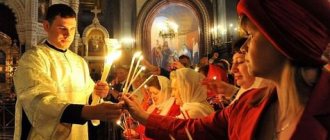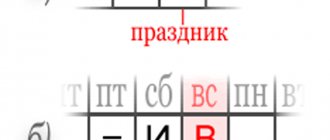For a modern Christian, the Sacrament of Communion is a rare event. But for the consciousness of a true believer, a rare communion with Christ is a punishment. He is burning with the desire to unite with Christ as often as possible, partaking of His Body and Blood - the greatest gift that the Lord has given us.
Lent, with its strict rules, does not provide for the celebration of the full solemn liturgy during the week, and, accordingly, the sacrament of the Eucharist. This required a special service at which believers could receive communion.
What is the Liturgy of the Presanctified Gifts
First, this service is not a liturgy in the full sense of the word. It lacks the Eucharistic canon. In essence, this is Vespers with the rite of Holy Communion. The Holy Gifts are prepared for her at the full liturgy (St. John Chrysostom or St. Basil the Great).
Origin of the phrase
The name of the Presanctified Liturgy comes from the fact that the Body and Blood of Jesus Christ in the form of bread and wine, with which believers must partake, are prepared, transubstantiated, and consecrated in advance. And the purpose of this service is to prepare people for Their acceptance.
Meaning of the concept
Liturgy translated from Greek means common cause. This is the main worship service of the Orthodox Church. The main purpose of this service is the Eucharist (Greek thanksgiving), i.e. communion with the Body and Blood of Christ, experiencing the Last Supper. Presanctified - consecrated in advance (meaning Holy Communion).
What is the difference?
Already from the name of the service it is easy to understand that the Bloodless Sacrifice is not offered at it. At such a service they partake of the pre-consecrated Body and Blood of Christ. The Holy Gifts are usually prepared at the last full Liturgy on Sunday. Therefore, during everyday services, proskomedia (remembrance of the living and the dead with the removal of particles from the prosphora) is not performed. Therefore, there is no need to file a note against it.
The main purpose of the Liturgy of the Presanctified Gifts is to provide communion to those who for some reason were unable to receive communion over the weekend. You need to know that at this service only those who are able to swallow the consecrated particle are suitable for the Holy Chalice. For this reason, infants are not given communion there.
Historical reference
Historically, this service is attributed to St. Gregory the Divine, a Pope who lived in the seventh century. In fact, it existed before, but in different variations. St. Gregory brought to the Roman Church ancient rituals that had been preserved in the East, including this divine service.
The emergence and development of liturgy
The performance of this service on the days of the Holy Pentecost (except for Saturday, Sunday and the Feast of the Annunciation) was approved at the Trullo Council of 691-692.
But at the council its completion was only officially confirmed, which means that it already existed. It is impossible to talk about the exact date of its appearance because the sequence of services developed over time.
The basis of this service—preparing the Holy Gifts in advance—appeared in the first centuries. The holy martyr Justin (beginning of the second century) wrote that Communion was prepared, and the deacons carried it to those who could not be at the service.
The Presanctified Liturgy appeared as a separate service when Great Lent began. And since during the week the solemn liturgies of St. John Chrysostom and Basil the Great were not celebrated; there was a need to prepare Holy Communion in advance, so that it would be possible to receive communion not only on Saturdays and Sundays.
Current situation
The Liturgy of the Presanctified Gifts should be celebrated in the evening at the ninth hour (according to Byzantine time), i.e. at three in the afternoon. But most often it is done in the morning.
The days on which this service is performed are as follows:
- on Wednesdays and Fridays of Lent, except for the Feast of the Annunciation;
- on Thursday of the fifth week;
- on Monday, Wednesday and Tuesday of Holy Week;
- on the Polyeleos holidays: the first and second Finding of the Head of John the Baptist (February 24, Art.), 40 Martyrs of Sebaste;
- temple holidays.
Liturgy of the Presanctified Gifts and its origins
As is known, the Liturgy of the Presanctified Gifts is the name given to the divine service performed on the weekdays of Great Lent, during which the Holy Gifts, consecrated previously at the previous full Liturgy of St., are offered to the faithful for communion. Basil the Great or St. John Chrysostom and preserved in a reliquary, usually on the throne or (less often) on the altar. The Sixth Ecumenical Council (52nd rule)2 approved the universal celebration of the Presanctified Liturgy on the days of the Holy Pentecost, so as not to deprive believers of mystical communion with the Lord and at the same time not to violate fasting and repentance by celebrating the Eucharist3.
The question of the origin of the Liturgy of the Presanctified Gifts is difficult4 because the earliest evidence of its existence dates back to the beginning of the 7th century. One of them is in the “Easter Chronicle”, which says: “This year, under Sergius Patriarch of Constantinople, from the first week of Lent, the fourth indictment (615), they began to sing after May it be corrected, during the transfer of the Presanctified Gifts from the skeuofylakion (co-conservator, special buildings next to the temple, where holy relics, sacred vessels were kept and proskomedia was performed5) to the Throne, after the priest says By the gift of Thy Christ, the people immediately begin: Now are the Powers of Heaven..."6
The oldest surviving manuscript of the Byzantine Euchologia (Vatican Library Barberini. gr. 336, late 8th century) contains prayers from the rite of the Liturgy of the Presanctified Gifts, not called “Liturgy,” but only “presanctified” (Fol. 38v-43v)7 . The service given in this Euchologia was performed in the evening, “at the time of the lamp, after the readings and May He Be Corrected, and Lord, Have Mercy, there is a prayer of the catechumens at [the performance of] the Presanctified.”8 By “readings” we mean parimia at vespers of Great Lent; intensive reading of the Old Testament during Lenten services is due to the ancient custom of preparing catechumens for Baptism on Holy Saturday or Easter; bishops and presbyters read the Holy Scriptures to the catechumens and pronounced catechumen teachings. Egeria talks about this in his “Pilgrimage”9; St. John Chrysostom mentions that the catechetical instructions were accompanied by the ritual of lighting lamps, which was necessary due to the fact that the instructions continued until the evening10. This ritual in our modern practice consists in the fact that the priest, coming out of the altar with a lamp in his hands, addresses the people with the words: The Light of Christ enlightens everyone. The use of this rite is recorded in monuments of the 3rd-5th centuries.11 The origin of this rite lies in the ancient Jewish (and even more widely - Mediterranean) pious tradition - when lighting the evening lamps, to say thanks for the light sent by the Almighty, so that people can see in the darkness of the night. In the Christian Church, this rite received a new meaning. A lamp brought into a prayer meeting reminded believers of the presence among them of Christ, Who called Himself “the Light of the world” (John 8:12 and 9:5).
Thus, the “catechetical” elements of the rite of the Liturgy of the Presanctified Gifts can be called: teachings to the catechumens and those preparing to receive baptism, which began in the afternoon and lasted until evening; the proclamation The Light of Christ enlightens everyone and the ancient ritual of bringing a lamp into the prayer meeting; responsorial performance of the evening (“lamp”) psalm 140. May my prayer be corrected. Communion was added to these elements, which became church-wide12. In Constantinople this probably happened between 531–536. during the reign of St. Emperor Justinian. In Constantinople, the frequent celebration of the Liturgy of the Presanctified Gifts became a custom - thus, St. Patriarch Nicephorus the Confessor ordered that the Liturgy of the Presanctified be celebrated on Wednesday and Friday throughout the year (unless a great holiday occurs on this day and the fast is not canceled) and on the Feast of the Exaltation of the Cross of the Lord. During Great Lent it was celebrated every day, and it was also celebrated on Good Friday. According to the Constantinople Studian-Alexiev Charter, which was in force in Rus' until the beginning of the 15th century, this Liturgy was celebrated on Wednesday and Friday of Cheese Week, on all weekdays of Great Lent, on the first three days of Holy Week and on Good Friday13.
According to Rev. K. Nikolsky, back in the 19th century. in the Kiev Pechersk Lavra, the Liturgy of the Presanctified Gifts was served throughout Lent, except for Monday and Tuesday of the 1st week14. This tradition of performing the Presanctified Service on the weekdays of Lent every day has undoubtedly been preserved from the time of the dominance of the Studite Rule. Nevertheless, this tradition was interpreted in the context of the Jerusalem Rule - the Presanctified Liturgy was performed daily only in the Caves, while polyeleos were sung daily in the Caves in honor of one of the saints buried in the Caves.
Days for the celebration of the Liturgy of the Presanctified Gifts according to the current Charter
The current Church Charter clearly defines the days on which the Liturgy of the Presanctified Gifts is celebrated. These are Wednesday and Friday during the first six weeks of Great Lent, Thursday of the 5th week (“Thursday of the Great Canon”), and the first three days of Holy Week. In addition, the Presanctified Liturgy should be served on Monday, Tuesday and Thursday of the 2nd - 6th week of St. Lent, if the polyeleos service is celebrated on these days. This tradition has existed in Rus' since the transition to the Jerusalem Rule and coincides with the modern practice of the Orthodox East15.
The category of holidays on which the Typikon prescribes the obligatory celebration of polyeleos on the weekdays of Great Lent and, therefore, implies the service of the Liturgy of the Presanctified Gifts, include: The First and Second Finding of the Head of John the Baptist (February 24, Art.), 40 Martyrs of Sebaste (March 9 Art. Art.) and the temple holiday.
It should also be noted that in the Russian Church, when the memory of St. Alexis of Moscow (February 12, Old Art.) coincides with the weekdays of St. On Lent, a polyeleos service should be performed (with the Liturgy of the Presanctified Gifts), as evidenced by the special instruction of the Typikon, placed under February 12: “If it is fasting: we will sing to him [St. Moskovsky Alexy. - priest S.V.] according to Markov’s chapter, as indicated by the Peti Finding of the Honest Chapter of the Forerunner” (Typikon, February 12, 1st “see”). This section of the Charter, which relates the memory of Saint Alexy of Moscow to the holidays on which a polyeleos service with the Liturgy of the Presanctified Gifts must be performed, is in many ways unique. The current Typikon as a whole is not characterized by the establishment of the memories of Russian saints as generally binding for the entire Russian Church, as well as a detailed presentation of services in honor of Russian saints. This instruction of the Charter should be all the more valuable for us.
During the first week of Great Lent, the celebration of the Liturgy of the Presanctified Gifts is possible only on ordinary days - Wednesday and Friday - and without polyeleos. Polyeleos holidays, coinciding with the 1st week of St. Pentecostals, according to the Charter, are postponed. If a temple or polyeleos holiday occurs on Monday of the 1st week of Lent, then the holiday service is transferred to the Week of Cheese (cf.: Typicon, 30th Yahram chapter, 7th Mark chapter on February 24). If a temple or polyeleos holiday occurs on Tuesday, Wednesday, Thursday or Friday of the 1st week of Lent, then the holiday service is moved to Saturday of the 1st week of Lent and is combined with the martyr service. Theodore Tiron (cf.: Typikon, 31st and 32nd Yahram chapters, 8th Markov chapter under February 24). Only starting from the 2nd week of St. On weekdays it is possible to perform a polyeleos service on Lent.
It should be noted that the memory of St. Alexis of Moscow, celebrated on February 12 (Old Art.), does not often fall on the days of Great Lent - only during early Easter. The current year, with the earliest Easter, has provided us with a rare opportunity to witness such a coincidence, in which the polyeleos service of St. Alexis of Moscow during the days of Great Lent was not postponed to another day, but was performed (with the Liturgy of the Presanctified Gifts) on the very day of celebration - Thursday of the 2nd week of St. Pentecostals. The last case of such a coincidence took place in 1915.
It should be especially noted that the celebration of the Liturgy of the Presanctified Gifts for the sake of burial or commemoration of the departed is an unacceptable and unjustified violation of the Charter, since the Presanctified Liturgy does not include the most important and effective commemorations: at the end of the anaphora (Eucharistic canon) and with the removal of particles in memory of the departed and their washing in Blood of Christ16. Precisely because the Liturgy of the Presanctified Gifts cannot be a funeral service, its rite does not provide for the recitation of a funeral litany and the addition of any funeral hymns (with the exception of the stichera at Vespers for the Lord, I cried on Fridays 2nd, 3rd and 4th weeks, since on the Saturdays of these weeks the remembrance of the dead is performed). Therefore, the Liturgy of the Presanctified Gifts should not be allowed to be celebrated on days other than those specified by the Church Charter17. Special mention should be made of the celebration of the Liturgy of the Presanctified Gifts on the extra-curricular weekdays of Great Lent with the blessing of the Right Reverend Archpastors (for example, on the days of memory of locally venerated saints, on namesake days or other celebrations). As a rule, this practice does not contradict the current Charter, since it exists in the context of the regulations of the Typikon, which allows the celebration of the Liturgy of the Presanctified Gifts during the polyeleos service.
Conclusion
Having considered the issue of the days for the celebration of the Liturgy of the Presanctified Gifts, it is impossible not to note that in order to resolve issues that arise in liturgical practice, one must, first of all, turn to the liturgical tradition of the Church, recorded in the liturgical books, as well as in authoritative manuals and interpretations of the Charter. It is necessary to learn the words of St. Athanasius (Sakharov), a prominent liturgist of the 20th century, about a careful attitude towards liturgical tradition: “There is nothing accidental in worship, in the Charter of the Orthodox Church, everything in it is strictly thought out. And everything, even the smallest details, have their own, often very deep meaning, impart their own flavor to individual orders and successions, give them a special touching and touching... Our worship is a highly artistic work, a complex mechanism of delicate work... And if sometimes the meaning of this or that detail is unclear to us divine services - this does not mean that it does not exist at all... It only means that we do not yet know how to understand it, we do not know it. We must find it and try to understand it for ourselves... From what has been said it follows how important it is for Orthodox Christians in the matter of prayer and worship to obey the Church Charter. It is important and necessary to perform the smallest details of church rites and services exactly as they are set out in the Charter, for only then will the divine service have the exact meaning that the Holy Church gives it.”18 It is obvious that in his vision St. Afanasy is based on the advice of St. Paul: “Then, brethren, stand fast and hold to the traditions which you have learned, either by word or by our epistle” (2 Thessalonians 2:15). This advice should also be a guide for every Christian who cherishes the “pearl of great price” (Matthew 13:45–46) of Orthodox worship.
- For more information about the historical development, theological aspects and liturgical features of the Liturgy of the Presanctified Gifts, see: Vanyukov S.A. Rite of the Liturgy of the Presanctified Gifts (Research of printed publications) // Theological collection. M., 2001. Issue. 8. pp. 269–294.
- See: Book of Rules of the Holy Apostles, Holy Ecumenical and Local Councils and Holy Fathers. M., 1893, 1992r.
- Wed: Alphabetical Syntagma: Collection in alphabetical order of all objects contained in the sacred and divine canons. Simferopol, 1892; M., 2006. P. 363.
- See: Uspensky N.D. On the question of the origin of the Liturgy of the Presanctified Gifts // Journal of the Moscow Patriarchate. M., 1976. No. 2. P. 71.
- See Taft RF The Great Entrance: A History of the Transfer of Gifts and Other Preanaphoral Rites of the Liturgy of St. John Chrysostom. R., 19782. (OCA; 200). P. 185–191.
- Chronicon Paschale // PG. T. 92. Col. 989.
- See edition of the manuscript: Parenti S., Velkovska E. L'Eucologio Barberini 336. Roma, 1995. (Bibliotheca “Ephemerides Liturgicae”, “Subsidia”. 80). P. 42–48.
- Ibid. P. 42.
- See: Maraval P. Journal de voyage; Pilgrimage to Holy Places / Per.I. V. Pomyalovsky // Orthodox Palestinian collection. St. Petersburg, 1889. T. 20. pp. 103–172.
- See Uspensky. To the question... P. 73.
- Right there.
- Historical data allows us to see Sevier of Antioch as one of the distributors of this practice.
- See: Pentkovsky A. M. Typikon of Patriarch Alexy Studite in Byzantium and Rus'. M., 2001.
- Nikolsky K., Archpriest A Guide to the Study of the Charter of Divine Services of the Orthodox Church. St. Petersburg, 19077; M.: Publishing Council of the Russian Orthodox Church, 2008. P. 458.
- Compare: `IeratikÒn. 'AqÁnai, 1995. S. 200.
- See: Afanasy (Sakharov), bishop. On the commemoration of the dead according to the Charter of the Orthodox Church. St. Petersburg: Satis, 1995. pp. 129–130.
- There is an assumption according to which Vespers of the Feast of the Annunciation, when its forefeast coincides with the weekdays of St. Pentecost must be celebrated with the Liturgy of the Presanctified Gifts, regardless of the day of the week (see for more details: Vanyukov S.A., Zheltov M.S., Felmi K.H. Annunciation // Orthodox Encyclopedia. M., 2002. Vol. 5. C 254–265; Vanyukov S.A. Chapters of the Annunciation // Orthodox Encyclopedia. M., 2002. T. 5. pp. 274–275). This opinion is based, first of all, on the analogy with the services of the Nativity of Christ and the Epiphany (the vespers of which are combined with the Liturgy when Christmas Eves fall on weekdays), and secondly, on the instructions of the old printed Rules, in which there is no rubric when describing the services of the vespers of the Annunciation: There are still no Presanctified Ones. In this regard, it should be noted that the tradition of celebrating the Liturgy of the Presanctified Gifts on the pre-celebration of the Annunciation, which falls on Monday, Tuesday and Thursday of the weeks of Great Lent (except for Thursday of the 5th week), has not been established in modern liturgical practice. Authoritative guides to the Divine Service Charter also do not consider the pre-celebration of the Annunciation as a day on which the celebration of the Presanctified Liturgy is obligatory (see, for example: Rozanov V. Divine Service Charter of the Orthodox Church. pp. 597–598; Nikolsky K., Archpriest. A manual for the study of the Charter Divine Services of the Orthodox Church, p. 458).
- Afanasy (Sakharov), bishop. On the commemoration of the dead according to the Charter of the Orthodox Church. St. Petersburg: Satis, 1995. pp. 22, 26.
Source: Moscow Diocesan Gazette No. 3-4 for 2010
https://www.mepar.ru/library/vedomosti/48/709/
April 4, 2012
How is the service going?
The text of the service differs in many ways from the usual one.
At the beginning the priest says:
“Blessed is the Kingdom of the Father and the Son and the Holy Spirit, now and ever and unto ages of ages.”
Vespers follows:
- Psalm 103;
- peaceful litany;
- kathisma (which is divided into 3 parts, after each there is a small litany).
At this time, in the altar, the priest transfers the Holy Gifts from the throne to the altar, accompanying this with incense.
Further:
- “The Lord cried out” with the corresponding stichera (at the same time the incense of the temple is performed);
- small entrance;
- reading of proverbs (preceded by prokeemnas).
After the second paremia, the royal doors open and the priest with a candle and censer facing the people says:
“The light of Christ enlightens everyone.”
After the third proverb, excerpts from Psalm 140 “Let my prayer be corrected...” are sung. This is followed by the prayer of Ephraim the Syrian “Lord and Master of my life,” accompanied by three prostrations to the ground.
After this, the order of the liturgy follows, starting with a special litany with petitions for those who should begin holy Baptism (catechumens). This is due to the fact that in the ancient Church Baptism was performed on Easter or Bright Week. At this moment, the unbaptized went out into the vestibule of the temple and did not participate in further worship. Therefore this part is called the Liturgy of the Faithful .
This is followed by the Great Entrance, which is preceded by a special chant:
“Now the Heavenly Powers serve with us invisibly, behold, the King of Glory enters: behold, the secret Sacrifice has been completed.”
The priest makes his entrance holding the paten over the chalice and says:
“Let us draw near by faith and love, that we may be partakers of eternal Life. Alleluia, alleluia, alleluia."
As stated above, there is no Eucharistic canon, which consists of prayers invoking the Holy Spirit for the offered Gifts.
Then follows:
- Prayer of Ephraim the Syrian with bows.
- Litany of petition.
- Our Father.
- Supreme prayer.
- The cry of “Holy of Holies.”
The clergy take communion at the altar, after which they give communion to the faithful. At the end, a special prayer behind the pulpit is read.
Origin of service
Mentions of the Presanctified Liturgy as a Lenten service are found already in the 6th century. What is the reason for its occurrence? As you know, fasting is a time of sorrow and contrition for one’s sins. Liturgy is always a holiday, a celebration, which is why it was also called Easter in ancient times.
In order not to disturb the general repentant mood of Lent, on the one hand, and not to deprive oneself of communion for a week, on the other, such a touching service was invented. We can say that the main pathos and feature of the service is the longing for communion. The presence of such a service in the church charter is proof that the early Christians received communion frequently.
There is an opinion that the Presanctified Liturgy arose from the ancient tradition of self-communion of Christians at home. It especially spread during times of persecution and was later adopted by hermit monks living in the desert.
Saint Justin the Philosopher mentions that deacons carried the Holy Gifts home to those Christians who, for some reason, could not receive communion in church.
This practice existed until the 15th century, and today, unfortunately, it has been completely lost. But in those distant times, self-communion of the laity was a common and everyday phenomenon, for which there is much evidence.
Morning Vespers
Why is it more correct to serve the Presanctified Liturgy in the evening? The peculiarity of the service is that it is performed together with Lenten Vespers. If you perform it at a later time of day, some words of prayers and chants will be perceived closer in meaning: “evening sacrifice”, “Quiet Light”, “Let us fulfill our evening prayer to the Lord...”
Vespers is preceded by the service of Lenten hours followed by the Fine Hours (another specific service). After the Lesser Entry of Vespers and the singing of “Quiet Light,” two passages from the Old Testament are read—proverbs. The first passage is from the Book of Genesis about the creation of the world and the Fall, the second passage is from the Proverbs of Solomon.
After reading the first paremia, three singers from the choir (church choir) go to the center of the temple and stand in front of the Royal Doors. Next comes one of the most memorable, soul-penetrating chants of the Liturgy of the Presanctified Gifts. These are selected verses from Psalm 140. In Russian they sound like this:
Let my prayer be directed like incense (fragrant smoke) before Thy face, and the lifting of my hands like the evening sacrifice. God! I appeal to You: hurry to me; listen to the voice of my prayer when I cry to You. Set, O Lord, a guard over my lips, and guard the doors of my mouth. Do not let my heart turn aside to evil words to excuse sinful deeds.
During the singing, everyone present in the church kneels, and the clergy censes in the altar. After this, the prayer of Ephraim the Syrian is said with three prostrations to the ground.
Why does the bell ring?
Another notable feature of the Liturgy of the Presanctified Gifts is the mysterious bell. It rings several times in the altar at the most important moments of the service. When we hear the ringing for the first time, we fall to our knees in admiration; when the bell rings again, we stand up. When does it ring?
- When the Holy Gifts are transferred from the throne to the altar. At this time, the Psalter, the third part of the kathisma, is read in the temple.
- After reading the first paremia, the priest takes a censer and a candle, depicting a cross in the air with the censer, and says: Wisdom, forgive me! With this he calls us to special attention. Then the priest turns to the worshipers and, blessing them, says: The Light of Christ enlightens everyone!
The candle symbolizes light; Christ is the Light of the world, in whom all the Old Testament prophecies came true. That is why a candle is lit while reading a passage from the Old Testament. As you can see, all the features of the service have their own deep meaning and symbolism. And nothing prevents us from enjoying this service “live” at least once during Lent.
Watch the video with commentaries on the Presanctified Liturgy here:
Question about the author
Traditionally, the author of the Liturgy of the Presanctified Gifts is called Saint Gregory the Dvoeslov. He lived in the 6th century and was Pope. The saint received his nickname from the names of the “interviews and dialogues” he wrote (literally “dialogue” - “double words”). His memory is celebrated on March 25.
But the most interesting thing is that the Holy Pope of Rome most likely was not the compiler of the rite of the Presanctified Liturgy. This is confirmed by recent scientific research. Among the authors of this service, the sources mention the names of Epiphanius of Cyprus, Herman of Constantinople, even Basil the Great. And not once - St. Gregory.
As you know, there is no smoke without fire. Why, after all, is Gregory Dvoeslov so strongly associated with the specific worship of Great Lent? Everything is very simple. This holy man really worked a lot in the field of church services, including in putting the services in order. It is likely that he had the opportunity to streamline and supplement the rite of the Liturgy of the Presanctified Gifts, as well as introduce it into general church use.
